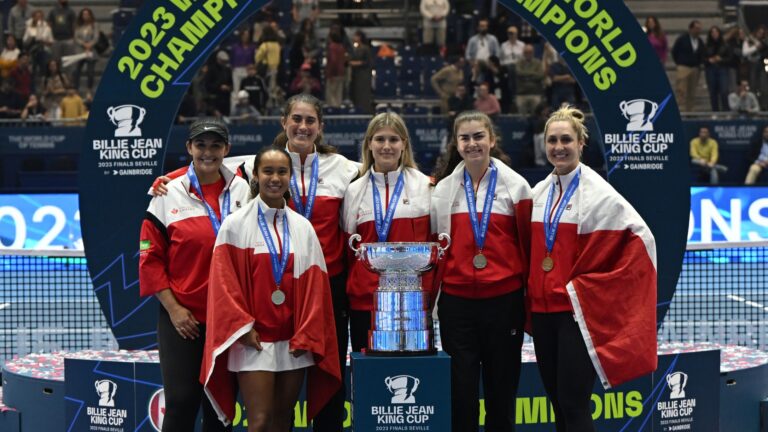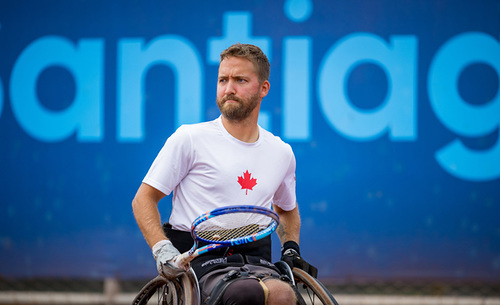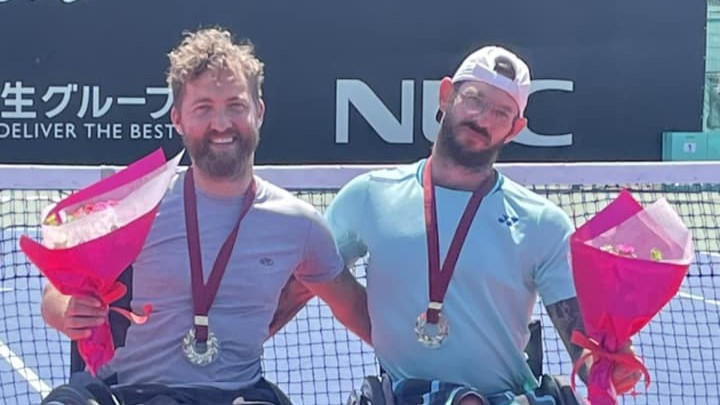
Ideally, the ATP World Tour Finals is a down-to-the wire extravaganza that ties a neat bow on the tennis year.
Unfortunately for tennis thrill seekers, the 2015 men’s season is done and dusted regarding the No. 1 ranking. Novak Djokovic has been so dominant that the only thing really left to determine is just how far ahead of the No. 2 – likely Andy Murray but still possibly Roger Federer – he will be.
Here’s how those three players stood entering this year’s World Tour Finals currently underway at the O2 Arena in London.
- Djokovic 15,285 points
- Murray 8,470 points
- Federer 7,340 points

Finishing in the top spot means Djokovic has been No. 1 in four of the past five years and four times overall in his career. That puts him one behind Federer, who has ended five years as No. 1 and ahead of Rafael Nadal who has been year-end No. 1 on three occasions.
At the moment Nadal is No. 5 in the rankings, just 10 points ahead of Tomas Berdych – 4,630 to 4,620. He will be eager to remain in that position in the final standings. It’s difficult to score victories over the mighty Federer in the tennis record books, but if Nadal can end 2015 in the Top 5 it will mark his 11th consecutive year (2005-2015) in that elite group. Federer has only managed 10 consecutive years in the Top 5 (2003-2012). So Nadal, despite injury issues at times, has a rare opportunity to one-up his longtime rival.
While Nadal, Djokovic and Federer have the most impressive CVs among the current players, this week Murray will be a focus of much attention, and speculation, with Britain’s Davis Cup final against Belgium on clay looming just five days after the World Tour Finals wrap up in London on Sunday, November 22.
In terms of career symmetry, it gives Murray a chance to join Nadal, Djokovic and Federer in leading his country to a Davis Cup victory. And it would be all the more meaningful because the other three had far superior supporting casts in their years of Davis Cup triumph. Murray, with apologies to his doubles-playing brother Jamie, is basically a one-man band.
So his Davis Cup quest is a subplot running through this year’s World Tour Finals.
Most people know he had suggested he might take a pass on the O2 Arena event to fully prepare for the Davis Cup final in the 13,000-seat Flanders Expo in Ghent. But immediately there were pressures on him to play in London where he is a resident and very popular.

At first glance, it appears that the draw for the event has been kind to Murray because he has Nadal, Stan Wawrinka and David Ferrer in his four-man round-robin group, avoiding having to play Federer who was drawn with Djokovic (they meet later on Tuesday with identical 1-0 records), Kei Nishikori and Berdych. On closer examination, it shapes up to be a hellish line-up of matches for Murray if he continues to win after his 6-4, 6-4 victory over Ferrer on Monday.
To begin with, he started on the second day (Monday) of competition, so he will have to play Friday, Saturday and Sunday this coming weekend if he is successful.
Also, if Djokovic and Federer are the semifinalists from their group as is expected, Murray would have to play Nadal, Wawrinka, Federer and Djokovic (possibly the latter two in reverse order) one after another with only one day off if he keeps advancing. Worst-case scenario, he’s likely to get to the semifinals on Saturday, meaning he would only have five days to get adjusted and fine-tuned on the clay before the start of Davis Cup the following Friday.
Tennis mavens will be on the lookout this week for any signs Murray appears to be saving himself for Davis Cup – such as looking as if he’s not too interested in getting into long, drawn-out matches. That could be an issue as soon as Wednesday (9 a.m. EST on Sportsnet One) when he faces Rafael Nadal.
In July, Murray suffered physically, just a week after reaching the Wimbledon semifinals and losing to Federer, when he played all three matches in Britain’s 3-1 victory over France in the Davis Cup quarter-final round on grass at Queen’s Club in London. This time, with the change of surface, it could be an even greater burden for him.
Ironically, the Belgians will probably be cheering like mad for Murray this week, hoping he will be beat up and more vulnerable by the time he gets to Ghent, a university town in northeast Belgium with a population of about 250,000.
So…while there will be excitement as to whether anyone can truly challenge Djokovic at the World Tour Finals, almost of equal interest will be how well Murray holds up with a view as to how fit he will be for Britain’s quest for a first Davis Cup title in 79 years.
Fed Cup in retrospect

The 2015 Fed Cup final at the O2 Arena in Prague last weekend went entirely to form in the four singles matches – then was decided by a somewhat hodgepodge doubles match.
Maria Sharapova, playing Fed Cup for her native land for only the fifth time since 2008, won her two singles matches over Karolina Pliskova (6-3, 6-4) and Petra Kvitova (3-6, 6-4, 6-2) for Russia and the Czechs responded with Kvitova and Pliskova each beating Russian No. 2 Anastasia Pavlyuchenkova.
That set up the fifth and deciding doubles match. Although Elena Vesnina and Pavlyuchenkova were dominant in the opening set, the host country’s Pliskova and Barbora Strycova came on strong and prevailed 4-6, 6-3, 6-2.
On the court, the weak link, unfortunately as she had also been in singles, was Pavlyuchenkova who simply does not seem to be a clutch player. She missed make-able shots at key moments in both her singles matches and also in the doubles.
You could just imagine Sharapova, the paradigm of a gutsy player as she showed in overcoming an in-form Kvitova in Sunday’s opening singles match, watching her hopes for a first ever Fed Cup championship disappear as Pavlyuchenkova fell victim to nerves.
The odd thing about the decisive doubles match was the participants. The big question is why was Ekaterina Makarova named to the team when she had not played since the US Open due to a calf injury. Sitting on the sidelines supporting the team was Svetlana Kuznetsova. The 30-year-old from St. Petersburg had shown some solid form during the fall season going 9-3 and winning the title at Moscow, one of the two final regular WTA events just three weeks earlier. Kuznetsova would have been a better partner than Pavlyuchenkova for Vesnina, who is an excellent doubles player currently ranked No. 8 in the WTA’s individual doubles rankings and No. 4 in the final 2015 team standings with Makarova.
There was also a notable absence on the Czech side, with the best doubles player (by ranking) in the tie, No. 4 Lucie Safarova, not well enough to play after a fall marked by a viral infection.
Surely Kuznetsova and Vesnina would have been a much more daunting pairing than Vesnina and Pavlyuchenkova, who had to play soon after losing 2-6, 6-1, 6-1 to Pliskova in the fourth singles match.
So the Czechs, winners of the Fed Cup four of the last five years, are the dynasty of recent times.

As for Russian star Maria Sharapova, after playing so little after Wimbledon because of leg and forearm issues, she had hoped Fed Cup success would end her season on a high note. She certainly did her part but it wasn’t enough playing away from home against a sound Czech team playing in front of a highly-partisan host country crowd.
Tennis Channel

A trip last week to the USA gave this writer a chance to watch Tennis Channel. It’s not available in Canada on cable and is not likely to be any time soon because of issues related to demand for a position on the various cable systems in the country.
When Tennis Channel is not covering a specific event – as was the situation last week – it relies on rebroadcasts of old matches. In this case, it was 11 classics from the Aussie Open.
The first one I saw was Pete Sampras against Andre Agassi in the 1995 Australian Open final. Most noticeable was that there wasn’t – of course – any Hawk-Eye. Sampras got a little hot about a few line calls and nowadays he would have the ability to challenge – but not then. In those days, the moment the ball had landed and went on its merry way it was ancient history. There were no real traces left behind except for the marks on clay courts.
A second match being replayed was Jennifer Capriati’s 4-6, 7-6(7), 6-2 victory over Martina Hingis in the 2002 final. A confession here as a reporter – I was surprised that I didn’t remember as much as I thought I would about the match. I recalled that it was an extremely hot day and that Hingis in particular suffered because of that.
At 2-2 in the final set, she doubled-faulted twice in a row on foot faults to drop serve. That was basically her last chance to win the match.
Then I remembered that the match started at 2 p.m. in Melbourne – 10 p.m. the night before in Toronto when I was writing for the Globe and Mail. By 4 p.m. or 4:30 p.m. at Melbourne Park, it was midnight or later in Toronto and I was flying by the seat of my pants trying to get a story done before the edition closed. It’s amazing how you spend your time writing and doing the best you can to keep up with the action – often relying on fellow reporters to fill in some of the details – but not really taking in every single nuance about the match. So it’s a stressful time and that’s probably why I didn’t recall as much as I thought I should.
There were a few other interesting matches, including the famous 2009 final when Rafael Nadal beat Roger Federer 7-5, 3-6, 7-6(3) 3-6, 6-2. That was the match when Federer bawled his eyes out during the presentation ceremony.
What was most striking was that Nadal was thinner than he is now – and even Federer looked lighter.
There was also the unforgettable five hour and 53-minute final from 2012 between Nadal and Novak Djokovic. I recalled more about that one especially that, leading 4-2, 30-15 and serving in the final set, Nadal made a fateful miss that probably allowed Djokovic to come back and win 5-7, 6-4, 6-2, 6-7(5), 7-5. Djokovic hit a not very good volley and Nadal only had to nudge a backhand pass down-the-line into the opening to lead 4-2, 40-15. But he hit it an inch or two wide to make the game score 30-all. Djokovic came back to break serve and go on to win what was the third of his five Aussie Open titles.
But the Serb had earlier had his chances to end matters in four sets. Leading 5-3 in the fourth-set tiebreak, he made three unforced errors in the next four points to lose it and force a winner-take-all fifth set.
A final note, there was about a 10-minute break to close the roof at 4-all in the fourth set because of rain. So what was the longest Grand Slam final ever was a little longer than it needed to be because of the roof closing.
There was also the famous 1995 quarter-final between Jim Courier and Pete Sampras after Sampras had learned that his coach Tim Gullikson had a brain tumour. Sampras was openly crying during the fifth set of a match he ended up winning 6-7(4), 6-7(3), 6-3, 6-4, 6-3. During the third game, Courier called across the net, “you okay Pete? We can finish this tomorrow you know.”
Finally, there was the Venus–Serena final from 2003. I didn’t remember who had won it and was keen to settle in and watch the finish – before I quickly remembered that all of Venus’ seven Grand Slam titles were won either at Wimbledon (5) or the US Open (2). So it was obvious she wasn’t going to win – Serena did 7-6(4), 3-6, 6-4.
It was fun to watch those matches, but it seems a shame that Tennis Channel doesn’t have a daily news segment with the latest happenings, no matter how meager they might be at times.
A Roger tribute to Michael
A guy called Jordan @rogerfederer #wtf pic.twitter.com/4eJC2Q4W3h
— rene stauffer (@staffsky) November 13, 2015
Roger Federer and Stan Wawrinka practiced together last week before the start of the ATP World Tour Finals in London.
Feature photo: The Times Photographer Marc Aspland for ATP


